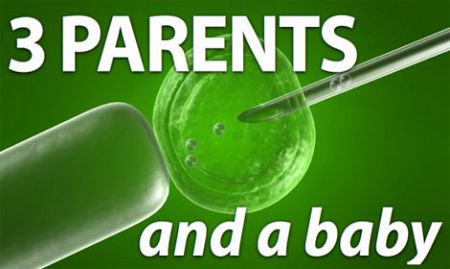British Parliament Approves Genetically Engineered “Three-Parent” Embryos
04/02/2015: Members of the British parliament today voted to make Britain the first country in the world to allow scientists to create three-parent genetically-engineered embryos, sometimes called “designer babies.”
In the process, the babies the babies, born from genetically modified embryos, would have DNA from a mother, a father and from a female donor. The British parliament voted 382 to 128 in favor of the technique and Prime Minister David Cameron allowed a free vote on the issue and voted for it.
Conservative lawmaker Fiona Bruce said the measure would lead to “designer babies.”
“Where will it lead? The answer has to be that we stop here. The answer has to be that we say this is a red line in our country, as in every other country in the world, that we will not cross,” she said during the debate.
Dr. Peter Saunders, a pro-life physician from Britain and a leading campaigner against three-parent embryos, says members of Parliament were worried Britain would appear scientifically backwards if it did not approve the plan.
“Last week forty scientists from 14 countries urged the British legislature to approve the new laws allowing mitochondrial DNA transfer,” he said. “The stance of scientists creates huge pressure for MPs who risk being labelled ‘ignorant’ or uncaring for objecting. But the question is not nearly as simple as it looks on first appearance. These new regulations are dangerous. No other country has officially legalised the techniques and no one can predict what the consequences for future children will be.”
“These techniques are highly experimental, unproven, known to be very unsafe (bear in mind that children’s lives will be the experiment), ineffective, costly, a waste of public money, insufficiently understood, unnecessary (only potentially helping 10-20 families a year) and will require large numbers of eggs to proceed, even for just a few families,” Saunders continued. “Genuine concerns about this new mitochondrial technology have been swept aside in Britain in the headlong rush to push the scientific boundaries.”
Public opinion in England runs counter to the idea.
The Department of Health is brazenly claiming widespread public support for the measure – despite its own consultation showing a majority (62%) actually oppose the plans. In addition a ComRes poll conducted in August 2014 found that only 18% of people support a change in the law to permit the creation of three-parent children through genetic modification.
In the technique, a donor egg’s nucleus is removed and replaced with the nucleus of a woman with mitochondrial disease. That genetically-engineered egg is then fertilized with sperm creating an embryo that has genetic material from three persons, the mitochondrial DNA (mtDNA) from the donor, and nuclear DNA contributed by the parents.
LifeNews blogger Rebecca Taylor, who works in the scientific field, talked more about the potential problems.
“And while it sounds like a nice thing to be able to help women who have mitochondrial disease to have healthy children (a woman with a mutation in her mtDNA cannot help but pass on that mutation because we inherit our mitochondria from our mother), there is a laundry list of ethical issues that finally seem to be gaining traction,” she explained.
She lamented the fact that mitochondrial replacement has more in common with SCNT, better known as cloning, than it does IVF.
“In both cloning and MR, the nucleus of a donor egg is removed and replaced with another. In cloning, the egg is made to think it has been fertilized. In MR, the egg is fertilized,” Taylor explained. “We know that SCNT in animals has had some serious problems. Cloning trials in agricultural animals in New Zealand were halted because an unacceptable number of the cloned animals and their gestating mothers had to be euthanized.”
This isn’t just a concern in England. In 2014, in the United States, an FDA Advisory Committee held a hearing examining mitochondrial disease prevention with the creation of three-parent embryos.


